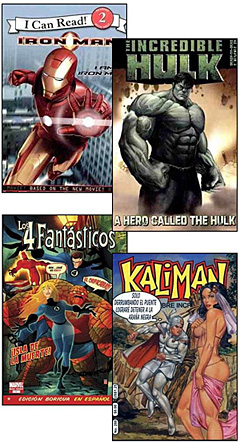
|  |  |  Entertainment | Books | January 2009 Entertainment | Books | January 2009  
Pulp's Perilous Possibilities: Can Comic Books Teach Kids to Read?
 Ed Hutmacher - MexicoBookClub.com Ed Hutmacher - MexicoBookClub.com


| | Can Comic Books Teach Kids to Read? There was a time when parents warned their kids that reading comic books would rot their brains, but today’s parents might as zealously urge their kids to put down the Xbox controller and just read something! |  |
In a Slate.com article last summer, Erica S. Perl reported that a new breed of early readers was feasting on comic books based on PG-13 action-adventure movies. Long gone or fading fast are the school primers that baby boomers grew up reading, such as the Dick & Jane pre-school books and Dr. Seuss' Cat in the Hat.

Fifty years ago, publishers and parents thought it was a good idea to create eye-catching, kid-pleasing books to foster early-literacy skills. But for Generation Ys’ brood of visually stimulated youngsters, it appears that the hottest early-reader books are more akin to "pulp" than Harry Potter, let alone Dick & Jane or Dr. Seuss.

Comic books like Iron Man and The Incredible Hulk can be found today in specifically labeled "At the Movies" racks in mega bookstore early-reader sections. Both DC and Marvel comics have age-appropriate titles — for preschool-age kids up to prepubescent teens — that feature various superheroes. Each comic book is crafted with a self-contained story so early readers won't get lost if they miss and issue or two.

"There’s no denying that kids, especially little boys, love their superheroes," Perl said, "and the whole point of early readers is to get kids excited about reading. But do you really want the Incredible Hulk teaching your kid to read?"

For most of us, probably not. There was a time when parents warned their kids that reading comic books would rot their brains, but today’s parents might as zealously urge their kids to put down the Xbox controller and just read something!

Given all the transnational, pop-cultural pollution that spills over the U.S.-Mexico border, you might guess correctly that this new genre of American-style comic book has caught on with Mexican kids and their parents. But not necessarily for the same reasons.

The Mexican comic book, often called historietas (literally, "little stories"), is Mexico's most popular print medium. They have been around in numerous forms since the 1920s and been read by all ages and socio-economic groups. And like kids everywhere else in the world, Mexican youngsters are introduced to comic books at an early age, and no one would argue that historietas can’t foster reading skills.

Of course, things are different in Mexico. From the outset, Mexican comic books served multiple purposes. Yes, they remain a kind of entertainment medium, a sort of escapist folk literature for the masses. But Mexican comic books have always incorporated any number of themes to enhance social awareness — such as class conflict, how Mexicans view the world, and a perennial favorite, the evils of U.S. cultural imperialism.

Mexican comic books are also distinguished by their superb graphics and sexually suggestive illustrations. I suppose Mexicans don’t see any harm with youngsters reading make-believe stories containing socially worthwhile subtexts with some erotic titillation tossed in for good measure.

For decades, the comic book Kalimán ("The Incredible Man") was read by just about every adolescent in Mexico. It had a remarkable run of 1,300 issues before ending production recently to be replaced by imported U.S. comic books translated into Spanish, like The Fantastic Four, though reprints of the popular Kalimán continue to be reissued. Our superhero doesn’t actually have any super powers but he is at the top of human perfection by being very strong and intelligent via esoteric wisdom.

Kalimán was described as representing a more sanitized and lofty version of "machismo" — his faultless integrity rose above the shortcomings of ordinary men and his Solomon-like acumen laid bare the deceits of dishonest authorities. His sidekick, Solin, was more Mexican looking than the exotic Kalimán and was viewed as a role model for children, a model of respectfulness and dependency. Kalimán was the epitome of virtue, and God help the uneducated miscreants who preyed on the innocent.

What any parent can appreciate about such do-gooder comic books, whether they are a tag-along to blockbuster movies or the creation of ingenious writer-artists, is that this kind of pulp fiction can indeed stimulate a youngster’s interest in reading, as well as provoke good deeds and honorable behavior. And less we forget what it was like to be a kid with imaginary heroes to look up to, remember that anything that can be imagined can be drawn, and anything that can be drawn can be understood far more easily than anything in print.

Ed Hutmacher is Editor in Chief of Mexico Book Club. For information on books with Mexico-related themes, visit the website at MexicoBookClub.com. |

 |
|  |



